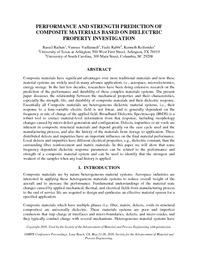| dc.contributor.author | Raihan, Rassel | |
| dc.contributor.author | Vadlamudi, Vamsee | |
| dc.contributor.author | Rabbi, Fazle | |
| dc.contributor.author | Reifsnider, Kenneth | |
| dc.date.accessioned | 2018-03-03T01:41:17Z | |
| dc.date.available | 2018-03-03T01:41:17Z | |
| dc.date.issued | 2016 | |
| dc.identifier.citation | Published in the SAMPE Conference Proceedings, 2016. | en_US |
| dc.identifier.uri | http://hdl.handle.net/10106/27244 | |
| dc.description | SAMPE Conference, Long Beach, CA, May 23-26, 2016. | en_US |
| dc.description.abstract | Composite materials have significant advantages over more traditional materials and now these material systems are widely used in many advance application, i.e., aerospace, microelectronics, energy storage. In the last few decades, researchers have been doing extensive research on the prediction of the performance and durability of these complex materials systems. The present paper discusses the relationship between the mechanical properties and their characteristics, especially the strength, life, and durability of composite materials and their dielectric response. Essentially all Composite materials are heterogeneous dielectric material systems, i.e., their response to a time-variable electric field is not linear, and is generally dependent on the frequency or rate of change of the applied field. Broadband Dielectric Spectroscopy (BbDS) is a robust tool to extract material-level information from that response, including morphology changes caused by micro-defect generation and configuration. Defects, impurities or air voids are inherent in composite structural materials and depend greatly on the cure cycle used and the manufacturing process, and also the history of the materials from storage to application. These distributed defects and impurities have an important influence on the final material performance. Local defects and impurities have different electrical properties, e.g., dielectric constant, than the surrounding fiber reinforcement and matrix materials. In this paper we will show that some frequency dependent dielectric response parameters can be related to the performance and strength of a composite material system and can be used to identify that the strongest and weakest of the samples when any load history is applied. | en_US |
| dc.description.sponsorship | The authors would like to thank Don Myers of Toray Composites America for the donation of carbon fiber prepreg material used in this research, and also would like to acknowledge the support from NASA and Institute of Predictive Performance Methodologies of University of Texas at Arlington. | en_US |
| dc.language.iso | en_US | en_US |
| dc.publisher | Society of the Advancement of Material and Process Engineering (SAMPE) | en_US |
| dc.subject | Broadband Dielectric Spectroscopy (BbDS) | en_US |
| dc.subject | Composite material -- load history | en_US |
| dc.subject | Complex materials systems -- strength | en_US |
| dc.subject | Complex materials systems -- life | en_US |
| dc.subject | Complex materials systems -- durability | en_US |
| dc.title | Performance and Strength Prediction of Composite Materials Based On Dielectric Property Investigation | en_US |
| dc.type | Conference Proceeding | en_US |
| dc.publisher.department | University of Texas at Arlington Research Institute (UTARI), University of Texas at Arlington | en_US |


